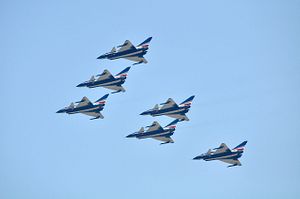One of the more headline-grabbing takeaways of the 2016 Defense Department report on Chinese military strength involves the size of the Chinese air forces, which now approach 3,000 aircraft. This number puts China ahead of any country in the world, other than the United States and Russia. However, the numbers bear more scrutiny.
Flight Global 2016 puts overall Chinese strength at 2,942 aircraft, including the PLAAF (1977) PLA ground forces (556) and the PLAN (409). U.S. overall strength, by contrast, sits at 13,717 aircraft across the four services (including the U.S. Marine Corps). U.S. numbers are weighted less heavily towards the Air Force, as the Army and Navy (including the USMC) have nearly as many planes as the USAF.
The compositions of the fleets also differ. The United States has around 2,200 short range fighters, compared to about 1,200 for China. Weighting by quality, the United States has an even more substantial advantage; China continues to fly over 400 J-7s, an effective aircraft, but not competitive in any sense with the U.S. fleet. The United States also has massive advantages in other aircraft types. The United States, for example, owns 78 percent of the world’s tanker aircraft; a unique capability for a state that views itself as having unique responsibilities.
How does size matter?
As with naval vessels, the overwhelming superiority of the USAF and USN only matters insofar as those forces can concentrate aircraft in the theater. This explains why the U.S. maintains a much heavier logistical “tail” than any comparable military; it needs to create the conditions under which it can wage a successful campaign against even a much weaker opponent.
And terrain, as such, matters a great deal. We don’t normally think of air combat in terms of “turf,” but in fact most air campaigns have involved strenuous efforts on both sides to set the terms of clashes by building and destroying “fortifications.” Indeed, the outcome of any air campaign depends greatly on the defensive fortifications that set its terms.
In the Combined Bomber Offensive of the Second World War, for example, the primitive (by modern standards) integrated German air defense helped starkly increase Allied casualties, just as British radar control had weighed heavily on the scales during the Battle of Britain. In Vietnam, North Vietnamese forces relied on a combination of SAMs and hit-and-run fighter tactics to force the Americans to pay higher costs; during Linebacker II, North Vietnamese SAMs seriously damaged the USAF’s strategic bomber fleet. By contrast, the general lack of successful defenses in Iraq (in 1991) and Japan (in 1945) meant that the Americans and their allies could operate virtually unimpeded.
Far more important than the size of China’s air force, thus, is Beijing’s effort to establish a territorial defense network that will allow Chinese aircraft to fight their U.S. counterparts under the circumstances of their choosing. And of course, the ability of the United States to shatter this defensive network (through stealth, unmanned cruise missiles, and other means) is key to U.S. success in any conflict.

































